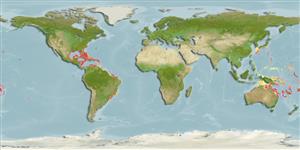Common names from other countries
>
Scombriformes (Mackerels) >
Trichiuridae (Cutlassfishes) > Lepidopodinae
Etymology: Evoxymetopon: Greek, eu = good + Greek, oxys = sharpen + Greek, metopon = brow (Ref. 45335).
More on author: Gill.
Environment: milieu / climate zone / depth range / distribution range
Écologie
marin benthopélagique; profondeur ? - 200 m (Ref. 13628), usually 100 - 200 m (Ref. 13628). Deep-water; 35°N - 29°S, 126°E - 39°W (Ref. 6181)
Western Atlantic: Bahamas, Caribbean Sea, and off southern Brazil (specimens found at the Institut für Seefischerei, Universität Hamburg collected from 24°40'S, 44°35'W). Northwest Pacific: Cheju Do Island, south of Korean Peninsula.
Taille / Poids / Âge
Maturity: Lm ? range ? - ? cm
Max length : 200 cm SL mâle / non sexé; (Ref. 6181); common length : 155 cm SL mâle / non sexé; (Ref. 6181); poids max. publié: 1.7 kg (Ref. 5217)
Rayons mous dorsaux (Total): 81-90; Épines anales 0; Rayons mous anaux: 60. Lateral line fairly straight, running mid laterally or slightly nearer the ventral contour than the dorsal contour. First anal fin ray scale-like, others ordinal and short. Pelvic fins reduced to a scale-like process spine. Body silvery white with slight red-brownish on dorsal part; several longitudinal pale yellow stripes on body.
Occurs on the continental slope and sometimes the continental shelf.
Life cycle and mating behavior
Maturité | Reproduction | Frai | Œufs | Fécondité | Larves
Nakamura, I. and N.V. Parin, 1993. FAO Species Catalogue. Vol. 15. Snake mackerels and cutlassfishes of the world (families Gempylidae and Trichiuridae). An annotated and illustrated catalogue of the snake mackerels, snoeks, escolars, gemfishes, sackfishes, domine, oilfish, cutlassfishes,. scabbardfishes, hairtails, and frostfishes known to date. FAO Fish. Synop. 125(15):136 p. (Ref. 6181)
Statut dans la liste rouge de l'IUCN (Ref. 130435)
CITES (Ref. 128078)
Not Evaluated
Menace pour l'homme
Harmless
Utilisations par l'homme
Pêcheries: pêcheries vivrières
Plus d'informations
Noms communsSynonymesMétabolismePrédateursÉcotoxicologieReproductionMaturitéFraiFéconditéŒufsDéveloppement de l'œuf
RéférencesAquacultureProfil d'aquacultureSouchesGénétiqueElectrophoresesHéritabilitéPathologiesTraitementMass conversion
CollaborateursImagesStamps, Coins Misc.SonsCiguateraVitesseType de nageSurface branchialeOtolithesCerveauxVision
Outils
Articles particuliers
Télécharger en XML
Sources Internet
Estimates based on models
Preferred temperature (Ref.
115969): 16.1 - 23.6, mean 19.5 (based on 75 cells).
Phylogenetic diversity index (Ref.
82804): PD
50 = 0.5625 [Uniqueness, from 0.5 = low to 2.0 = high].
Bayesian length-weight: a=0.00214 (0.00094 - 0.00484), b=2.99 (2.78 - 3.20), in cm Total Length, based on LWR estimates for this species & (Sub)family-body (Ref.
93245).
Niveau trophique (Ref.
69278): 4.5 ±0.7 se; based on size and trophs of closest relatives
Résilience (Ref.
120179): Faible, temps minimum de doublement de population : 4,5 à 14 années (Preliminary K or Fecundity.).
Fishing Vulnerability (Ref.
59153): Very high vulnerability (90 of 100).
